TERRACYCLE NEWS
ELIMINATING THE IDEA OF WASTE®
Posts with term ZWB X
Ep 60 - The Glow Down: Your Ultimate Guide To Zero Waste Beauty!
Where to Recycle and Donate Your Old Clothes
swap:
If you have clothes in good condition, maybe call up some of your friends and host a clothing swap. If you’re looking for tips on hosting your own clothing swap, check out this post where I chatted with Martha Stewart.sell:
If you have clothes in good condition and in current styles, you might want to consider selling some of your clothes. You can do it on apps and websites like Poshmark, eBay or check out Bunz an app for sharing, swapping, and trading in your local area. If you want to take a more hands off approach, you could also bring your clothes to a local consignment shop. You can take a look at some of my favorite consignment shops in my Going Zero Waste Guide to the Bay Area.donate:
When it comes to donating, try to find specific charities for specific items. I talk about this at length in my book 101 Ways to Go Zero Waste. Women’s Work Wear: Have work attire? Check out Dress for Success. “Dress for Success is an international not-for-profit organization that empowers women to achieve economic independence by providing a network of support, professional attire and the development tools to help women thrive in work and in life.” Bras: If you have a bra that’s a bit too tight or a bit too big, check out I Support the Girls. It’s also a great organization to donate your leftover pads and tampons, if you still have a stock pile from when you switched over to zero waste period products. “I Support the Girls collects and distributes donations of new and gently used bras, and individually sealed tampons and maxi pads to women and girls nationally and internationally. “Whether they be homeless, refugees, in transitional housing, or fleeing domestic violence, women and girls should never have to compromise on dignity.” Men’s Work Wear: Looking to donate men’s suits? Check out Career Gear. From their website, “We promote the economic independence of low-income men by providing financial literacy training, a network of support, professional attire, career development tools, job-readiness and essential life-skills training that help men enter the workforce, stay employed and become role models and mentors to their families and communities.” Bridal: Are you looking to donate your wedding dress? Can I recommend Brides Across America? From their website, “Brides Across America (BAA) is a non-profit committed to loving one another by gifting weddings and wedding gowns to our military & first responders. Whether it's for love of country or love at the altar, our military and first responders deserve our very best. Since 2008, Brides Across America has played a role in making their dreams come true by giving a military or first responder bride a free wedding gown during an “Operation Wedding Gown Event”. To date we have gifted over 20,000 wedding dresses and over 20 free weddings. Each year we host dozens of Operation Wedding Gown giveaway events at participating bridal salons nationwide. Events are held in July (around Independence Day) and November (around Veteran's Day).” Prom: Do you have some formal gowns, clutches, or sparkly earrings collecting dust in the back of your closet? Check out W Girls, Project G.L.A.M. From their website, “WGIRLS Inc. created Project Granting Lasting Amazing Memories (G.L.A.M.) to provide economically disadvantaged young women with prom dresses and accompanying accessories so they are able to enjoy the rite of passage of high school prom. To date, WGIRLS Inc. has outfitted over 14,000 young women in need for prom." Coats: Have a few extra coats? Maybe one or two your kids have outgrown? Check out One Warm Coat. From their website, “One Warm Coat is a national non-profit organization that works to provide a free, warm coat to any person in need. “One Warm Coat supports individuals, groups, companies and organizations across the country by providing the tools and resources needed to hold a successful coat drive. Coats are distributed in the communities where they were collected, to children and adults in need, without charge, discrimination or obligation. Since One Warm Coat’s inception in 1992, we have worked with our volunteers to host more than 31,000 coat drives and have given away more than 5 million coats.” Kids: I feel like kids are best known for one thing - growing quickly. There are numerous charities and organizations that accept gently used kids clothing and toys.- If you’re in Los Angeles, try Baby2Baby.
- If you’re in NYC or Boston, check out Room to Grow.
- If you’re in Washington, check out Clothes for Kids.
recycle:
Now, what do you do when you have a bunch of clothing that isn’t fit for swapping, selling, or donation? Then it comes down to textile recycling. Now, with all recycling, I’m a little wary. Recycling is not a charity, it’s a business and it relies on having a market to sell the products. So, just because we can recycle it doesn’t mean it will be recycled. This is why it’s better to reduce, reuse and THEN recycle. Upcycle: Cotton t-shirts make great rags. Think about cutting your tees into a squares of fabric for cleaning, napkins, hankies, etc. Compost: If your clothing is made from natural fibers like cotton, wool, silk, etc. you can compost it. However, the threads used to stitch it will 99% of the time be synthetic. Textile Recycling:- If you’re in San Francisco, there’s a textile recycling program run through the SF Department of the Environment.
- I:CO is working towards closing the loop in the clothing industry and recycle textiles into yarn, shoe soles, etc.
- Blue Jeans Go Green is dedicated towards recycling denim and turning it into insulation in homes. Madewell, Jcrew, Rag and Bone, they pop up in stores all across the US.
- Regrind your shoes with Nike regrind and turn them into basketball courts or tracks.
- Check out your local reuse center like the East Bay Depot for Creative Reuse a lot of towns have these, so maybe check around to donate scrap fabric.
- TerraCycle has a zero waste box specifically for textiles but it is spendy!
fixing the cause:
While donating and recycling is great, I can’t leave this blog post without mentioning that we should change our consumer habits. It’s important to reduce the amount we buy, hone in on our personal styles, shop only with lists, implement a buy ban like waiting thirty days, and stop shopping as a hobby. I hope you’ve found this blog post helpful and will use it as a reference the next time you clean out your closet!How to Spring Clean Your Closet
There is something about spring that always seems to inspire cleaning. As temperatures warm up after a long, dark winter spent inside with little opportunity to ventilate with open doors and windows, you might find yourself digging through layers of coats, scarves, and sweaters in your closet. While looking for those warm-weather essentials, you have probably said to yourself, “It's time to clean out this closet.”
RELATED: 8 Ways to Give Your Bedroom Sex Appeal
This means it’s the perfect time for a good spring cleaning. We talked to some experts who know a thing or two about how to get a closet organized and keep it that way. It’s not as difficult a task as you might think.
Start With a Plan

First things first: Don’t be too hard on yourself if you have accumulated a lot to deal with since the last time you cleaned out the closet). Not everything has to be tackled at once. California Closets design consultant Nicole Caswell recommends tackling one section at a time so the whole project isn’t overwhelming.
“The easiest way to to start the decluttering process is to really see what you’ve got. Go into the project knowing your end goal,” says Caswell. “Do you want to minimize your wardrobe, display your clothing, or organize your pieces by season? You will more likely achieve a well-organized closet if you are focused on a specific end result.”
“Avoid stress with a realistic goal,” San Francisco-based professional organizer and "Thumbtack Pro" Molly Cole of Cole + Co tells us. “A lot of my clients tell me they feel like they make an even bigger mess when they try to organize their closets.” She advises that even if you only get rid of a couple of items, you’ll feel better about your project if you achieve what you initially set out to do. “Have a plan for the items you decided to part with [and] remember to give yourself time to make that run to [a donation center such as] Goodwill.”
Fellow Thumbtack Pro Michael Dimopoulos of Lazy Susans Cleaning Service in New York City recommends taking the following into consideration before starting: “If I’m just seasonally rotating my wardrobe, I need to be clever about what stays and what goes, in the event that I need to find a particular item.”
Know Your Personal Limits

“Our closets are extremely personal, and there is not a ‘one method fits all’ approach to reorganizing your belongings,” points out Caswell. “Some might want to toss out their items and save the bare minimum, while others may want to keep everything and maximize their storage space.”
“Any method that gets you past procrastination is the best one for you,” agrees Lynnette Khalfani-Cox, clothing resale app Mercari’s finance expert and founder of Ask The Money Coach. “[According to a recent Mercari study] Americans currently have an estimated $93 billion in unused stuffcluttering our homes … just take the first step!”
The KonMari Method is the organizing method du jour, but watch for variations on the theme. “It’s important to remember that nostalgia is not your friend,” says Cole. “Many people want to hold on to items, not because they have any practical use, but simply because it brings up memories” She encourages her clients to think about the actual memory an item is connected to. Does it bring up a happy memory or a sad one? “If it’s the latter, it’s probably time to let it go,” she says.
“KonMari is very popular, but I found that it wasn’t for me,” The Container Store’s closet buyer Jimmy Seifert says. “It’s extreme … We like to hold on to things that have meaning … It’s easy to get rid of something that you’ve been holding on for years if it doesn’t mean much to you.” He swears by the Japanese minimalism book titled “Goodbye Things,” wherein author Fumio Sasaki changes his life by getting rid of everything he doesn’t absolutely need. “That actually pushed me to go beyond my comfort zone.”
RELATED: How Often You Should Be Replacing Your Sheets
Seifert recommends hiring a service, suggesting that some can even help with a move; purging, packing, and organizing as you leave one dwelling for another.
“It’s very important to give your space a once-over and remove items — especially big ones — that you want to get rid of before you start,” Cole says as a big believer in purging before organizing. “This clears up space and makes organizing much easier in the long run. I like to designate a space for those items outside the ‘organizing zone’ so you’re not stepping over anything or creating more clutter.”
Jordan Barnes, senior director of brand and communications at Mercari, likes to follow this rule of thumb: If you haven’t worn it or used it in a year, get rid of it. “Take a good look at all the stuff in your closet you’re no longer using,” she says. “Think about why you bought it. Maybe you moved to a new city with different weather. Maybe you upgraded to a newer phone. Maybe you just never got around to actually wearing those athletic shoes. You bought all that stuff for good reason [and] so will someone else.”
Maximize the Most Minimal Space

Even professional organizer Dimopoulos admits to feeling the limitations of space. “Living in New York City, unfortunately most of us don’t have much of a choice but to keep some things in off-site storage. You could vacuum-seal heavier items such as coats jackets, and bags, and stack them on top of one and other to maximize the space … or the lack of it.”
Start by paying attention to how you fold. Cole recommends the KonMari folding method (check out YouTube for how-tos) for storing items vertically in drawers, maximizing space and accessibility. Sort clothes in the closet by type, then color. “Organizing is not just about clearing clutter; it’s also about making things aesthetically pleasing,” she points out. “I like to use this notion when organizing a closet, primarily because [it] tends to involve a lot of daily decision-making … which can cause stress and anxiety. If you wake up to a nicely organized closet, you’ll not only feel less stressed as you get dressed for work, but you’ll also feel a great sense of accomplishment when you get that daily reminder of the hard work you put in to organizing that space.”
 The Container Store
The Container Store“When I am done with everything, I then have the space to coordinate and organize T-shirts, hanging or folded together, long-sleeved T-shirts, sweaters, shirts, jeans, trousers, etc.,” Dimopoulos agrees. “Everything has room to breathe. The ability to see everything is important. I now feel lighter and cleansed and have a sense of being organized.”
Caswell likes utilizing boxes, jewelry drawers, slide-out pant racks, and cabinet doors to store, display, and organize clothing. “When everything has its place, clutter is eliminated,” she points out. “When hanging clothing, make sure to purchase higher quality hangers that are preferably all the same. By keeping hangers, boxes, and containers consistent, your closet looks instantly cleaner.”
Of course, as a buyer for The Container Store, Seifert isn’t short on storage ideas. “Basic shoe storage is probably the most common issue. We also have hangers for just about anything: wooden are best if you have the space, but we also have space-saving ones. Bins and storage boxes are next: I use bins for things that I wear often, keeping them lower in my closet so I can see them. Boxes go up high for seasonal stuff. We also recommend drawer dividers to keep like items together. We have plastic versions, as well as cedar to prevent pests [such as moths].”
RELATED: How to Make Your Apartment Look Bigger
Seifert also shared his thoughts on plastic, both for its environmental impact, as well as whether it’s good for clothing storage. “It depends on what you’re storing,” he says. “We use the phrase ‘fur, feathers, and leathers.’ All of those things need to breathe. If they don’t, they can deteriorate or get moldy, so we recommend cotton storage for them. I wouldn’t put them in a box: Bins are best, or hangers. Cottons and synthetic materials are fine in plastic, though — I use clear plastic boxes for all my sweaters.
“As an alternative to plastic, we carry a brand of post-consumer fiberboard boxes from Sweden called Bigso,” he continues. “If you’re going to buy plastic, buy high-quality products that will last a long time and that don’t have to be replaced often because they crack and break easily. When you are done with them, they can be recycled.”
Donate, Sell, and Recycle the Rest

Still, now that your closet has been organized and styled, donate what you can’t sell to local charities. “It’s a good idea to review your items at least once a year,” says Caswell, “and if you don’t wear it, find it another home.”
Dimopoulos is a big believer in giving away clothes such as great sweaters, jackets, bags, and coats. “Luckily, I’ve always had someone in my life whose taste in clothes I admired … and who had the best brands that I couldn’t afford,” he says. “I love hand-me-downs. In fact, [over half] of my leather jackets, luxury brand bags, wallets, and coats are from upscale brands that I’d never buy at full retail.” Don’t be afraid to give things to friends and family that might not be as concerned that last season’s styles aren’t exactly “au courant.”
He even suggests doing what he does and always buying second-hand since, by his thinking, it means he saves more. “So yes, I ‘pay it forward’ by donating my excess wardrobe items.”
A quick survey of some of the larger “thrift” charities’ websites suggests that you can donate just about anything, from clothing, shoes, and boots to hats, gloves, and scarves, even some housewares and collectibles. Don’t donate things like personal care items and fragrance. The “Golden Rule” of thrifting applies here: Don’t donate to others that which you would not buy yourself (even if you’re not a second-hand shopper).
Toss or better yet, recycle pilled knits, clothing with holes, used swimsuits, underwear and socks … and anything that smells too bad to ever freshen up or that is badly stained. There are resources for clothing recycling such as Planet Aid which focuses on specific populous areas, TerraCycle which allows for bulk shipping of old textiles, and Earth911 which has an easy search feature that makes it quick and easy to find a drop-off location near you.
If you feel like taking the time, this is also the point at which your discipline may turn profitable. Apps and websites such as Let Go, Mercari, Grailed, Poshmark, The Real Real, even Amazon or the granddaddy of them all, eBay, may allow you to turn certain items back into cash. If you’re a real brand or label fan who has only worn your expensive things a few times or less, this has more potential than clothes or accessories that are in your regular rotation.
Khalfani-Cox suggests doing a quick search to see how much items similar to yours are selling for. That will help you decide whether it’s worth the effort to sell them or just make a donation. “For things you’d like to donate, bear in mind that, over the past few months, organizations like Goodwill say they’ve been overwhelmed due to the popularity of the KonMari tidying method,” she says.
A New Hope

Once those donations are made, Seifert recommends paring down shopping habits now that you’ve got room for a fresh start. “I find myself buying things that aren’t as trendy, focusing on more classic items that I can have for years if I take care of them,” he says. “I may have less, but what I do have is higher quality. I buy a lot more solid colors so I end up purchasing less all around. That’s a good next step.”
Spring is always a great season to whip that closet into shape and start the green season fresh. Remember, this is not reality TV: Do things at your own pace and set realistic goals. Ask an expert for advice, which could be an organized friend, a hired hand, or even just found within the pages of a book. Be sure to have a clear separation between the “toss pile,” and what you’re keeping.
If you live in a small space, and can afford it, don’t overlook off-site storage if that’s the best solution for you. The “spark joy” conversation may be one best saved for your therapist … even Martha Stewart admits to having a bit of a hoarding mentality. Once you’re done, remember to sell, give away, or donate your cast-offs to your favorite charity.
12 Companies That Are Making It Easier to Produce Less Trash
It's official: The world has a trash problem. Landfills are filling up, recycling is becoming more expensive and less attractive to municipalities, and a lot of trash is finding its way into our parks, rivers, oceans—even our drinking water.
When trash is dumped in the landfill, it emits methane, a greenhouse gas that contributes to climate change, and when trash is incinerated it emits carbon and toxins that cause health problems. Many regions are running out of space to store their trash, so they're shipping it to far-off locations around the country and around the world.
That method of trash disposal has worked relatively well for the regions dumping their trash, but it's caused problems for the people who live where the trash is received. Yes, whichever way you slice it, that ever-mounting pile of trash will keep causing problems if we don't take charge of the situation.
For decades, municipal ordinances and business practices have made it difficult for ordinary consumers to easily and effectively reduce the amount of waste they generate. Convenience products and tempting time-savers have flooded the market and it's understandable why they've become popular fixtures in the average American home.
Unfortunately for the health of humans, animals, and plants, those convenience items come at an environmental cost. But the tides are turning: More than ever, consumers are eager to simplify their lives and explore sustainable living practices that brings health, balance, and cost-savings to their lives, while at the same time minimizing waste. And there are a number of companies making it easier than ever to live a sustainable life.
Scroll through to learn how several companies are helping ordinary people make healthy choices for their home, their family, and their planet.
By Caitlin Castelaz Time was, the zero waste movement was led solely by a fringe group of do-gooders who eschewed highly packaged big brands in favor of more sustainable (yet hard to find) alternatives. Today, as bulk foods sections arrive in mainstream grocery stores and demand for waste-free farmers markets increases, the shopping landscape has changed dramatically—and big brands have taken note. In response to the cultural shift, large brands like Unilever, Clorox, Procter and Gamble, and others have banded together to create Loop, a grocery delivery service that emulates the milkman delivery model of old: mainstream products like Pantene shampoo, Häagen-Dazs ice cream, Degree deodorant, Hidden Valley ranch, and Tide laundry detergent delivered to your door in reusable, returnable containers. When you're ready for a new delivery, make your order, leave your empty containers outside your door, and await the arrival of the UPS delivery driver who will bring familiar favorites in an unfamiliar, yet delightfully innovative, new way. Visit LoopStore.com to sign up to be notified when the service launches later this year. For those who are ready to declutter their cosmetics shelf and create less plastic waste, there's bottle-free shampoo. With a small footprint and no packaging, Lush shampoo bars offer variety and cost savings, as well as space-saving and environmental benefits. Available in several flavors like rose, lavender, citrus, and honey-toffee, each bar-soap-sized puck equals two to three bottles of liquid shampoo—up to 80 washes—and sells for as little as $10.95 per bar. Available at LushUSA.com; from $10.95. As the market for recycled plastic shrinks, some municipality recycling programs are no longer accepting plastic. If your region still accepts plastic products, chances are it won't process—and has never processed—plastic toothpaste tubes. Toothpaste tubes are often made out of multiple types of plastic, and coated with remnants of toothpaste, making them difficult to recycle. To eliminate these awkward plastic items from the waste stream, some zero waste advocates make their own dental cleaning solution from baking soda and coconut oil. If the thought of slathering baking soda on your chompers sounds extreme, there's another low-waste alternative: Bite. This up-and-coming brand creates small toothpaste bits—about the size of a tablet of gum—packaged in glass jars. Crunch down on the toothpaste to release the cleaning lather, and brush as normal. Sign up for a subscription, and Bite will deliver another batch to your door, packaged in a compostable bag, whenever you need it. Available at BiteToothpasteBits.com; from $12. Another bit of plastic that municipal recycling programs won't accept? Plastic cling wrap. If you want to keep this trash out of the landfill, you can ditch food wraps altogether and opt for reusable food storage containers. However, if you aren't ready to say goodbye to the convenience of wrapping leftover produce, marinating meats, or tomorrow's lunch, there's a sustainable solution in Bee's Wrap. This company offers reusable food wraps made of cotton cloth coated in beeswax to create a pliable, bendable, wrappable material that can cover sandwiches, snacks, leftovers, bread, and more. After use, the wrap can be wiped clean, then used again and again. When it finally loses its sticking power, it can be kept out of the landfill and sent to the compost heap. Available at BeesWrap.com; from $6. They say one man's trash is another man's treasure, and for TerraCycle that expression couldn't be more true. This company recycles all manner of waste types that municipal recycling programs won't accept. Water filters, batteries, pens and markers, broken action figures, cereal bags, cassette tapes, worn plastic lawn furniture, pet bowls, electronic waste, shoes, stuffed animals, flip flops, insulin needles, and much more—all of it can be salvaged, sterilized, and recycled by TerraCycle, funded by like-minded companies. Visit TerraCycle.com to learn about their full range of recycling programs.Flip and Tumble
Give Flip and Tumble's produce bags a chance and you won't go back to using the plastic produce bags available in grocery stores. While plastic bags are prone to ripping, cause food to spoil when transferred to the fridge, and clog your kitchen junk drawer—sturdy, washable and breathable Flip and Tumble bags endure for years and countless uses. Not only do they make life just a little easier, but they're gentle on the environment by eliminating plastic from the waste stream. Available on Amazon; $12 for a set of five bags. When you think about it, selling soap in packaging doesn't make a ton of sense. After all, if there's any product that doesn't need the sterile protection offered by packaging, it's an item designed to deliver germ-busting cleaning power. Bring a couple bars of Good soap home from the store and rinse before washing your hands to remove any dust that gathered in transit. These bars, available in several scents, last longer than a standard-size bottle of liquid soap and deliver the same cleaning ability. Available at Whole Foods.Seventh Generation
Yes, we're going there! If the entire purpose of a product is to become trash, why should it be made of new materials? Seventh Generation believes that anything that's destined for the trash should be made of recycled materials, thereby reducing waste. That's why all of their paper products like bath tissue, facial tissue, and paper towels are made of 100% recycled paper. Consumers who strive for a plastic-free life will love the varieties of bath tissue that are wrapped in paper packaging instead of the traditional plastic. Visit SeventhGeneratiDr. Bronner's
America's favorite Castile soap has long been a staple in the hygiene section at health food stores, many of which sell the soap in bulk. Buy a plastic bottle of the stuff once, then return to the store to refill your bottle—or bring your own jar from the start. Visit drbronner.com for store locations. Ziplock bags generate a lot of plastic waste in homes across the country. Whether you use them to pack lunches, store freezer meals, or marinate dinners, chances are you use them once, then toss them in the bin (most municipalities won't recycle the bags). If you're stuck on these sealable bags, there are several reusable options on the market—including those produced by Full Circle. Available in several sizes, these leak-proof, BPA-free reusable plastic bags can be labeled with a dry erase marker, then wiped clean, and placed in a dishwasher for easy cleaning. Available on Amazon; $13.49 for a set of four bags. With the rise in minimalist mindsets and environmentally conscious lifestyles, there's been a growth in zero-waste and lower waste grocery stores and outdoor markets. Do some exploring in your hometown to see what options are available to you. To help you on your journey, Zero Waste Home, a free web-based app, provides a directory of grocery stores, markets, and pet stores with bulk foods and zero-waste hygiene products. So go ahead and log on—and happy exploring! Available at Zero Waste Home; free.12 Companies That Are Making It Easier to Produce Less Trash
TerraCycle
12 Companies That Are Making It Easier to Produce Less Trash
Loop
You're recycling your beauty products all wrong
Inside Canary, the New Refillery and Zero Waste Market in Kensington
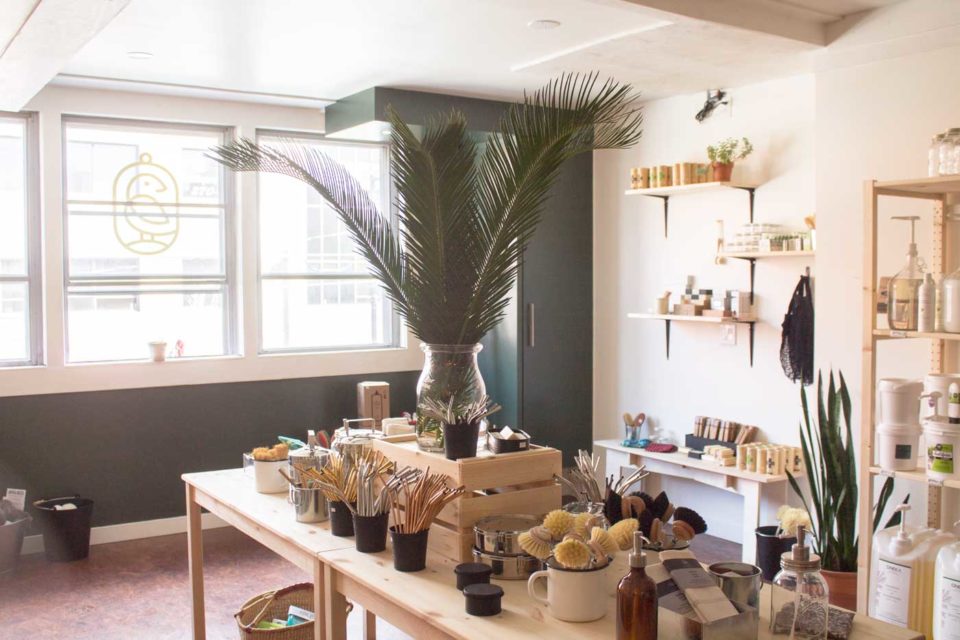 From the launch of the Calgary Composting Facility in 2017 to the more recent push to get rid of plastic straws in local restaurants, more and more Calgarians have environmental issues on the brain. Canary, a new refillery and zero waste market in Kensington, is the latest addition to that conversation in Calgary.
Launched by longtime friends Tara Meyer and Lisa Watts, Canary specializes in sustainable, plastic-free lifestyle products. Most of the store’s products are package-free and the rest come in recyclable/compostable packaging. There are blocks of Savon de Marseille soaps, shampoo and conditioner bars, Ziploc bag alternatives like reusable Stasher bags, dryer balls, sustainable brushes, stainless steel straws, bamboo toothbrushes and more.
Canary also has a refillery section where containers can be filled (and later refilled) with things like shampoo, conditioner, shower gel, bubble bath, lotion, deodorant, hairspray and toothpaste.
While many of Canary’s customers are already familiar with the idea of zero waste and sustainable products, others are discovering just how many sustainable options are out there for the first time. The goal, Meyer says, was to create a space where people could easily discover and access environmentally friendly products and start thinking about how they can make a difference in small ways.
“We’re simply hoping that people might start thinking about [things like] what’s one thing I can switch out that’s an easy swap to make? Like maybe this month, when my razors run out, I’m going to think about getting a metal razor and see how that goes. And if I like that, great. That’s one thing you’ve done and one less thing that goes to landfill,” Meyer says.
“When lots of people do little things like that, it really does add up.”
1223 Kensington Rd., canarygoods.ca
From the launch of the Calgary Composting Facility in 2017 to the more recent push to get rid of plastic straws in local restaurants, more and more Calgarians have environmental issues on the brain. Canary, a new refillery and zero waste market in Kensington, is the latest addition to that conversation in Calgary.
Launched by longtime friends Tara Meyer and Lisa Watts, Canary specializes in sustainable, plastic-free lifestyle products. Most of the store’s products are package-free and the rest come in recyclable/compostable packaging. There are blocks of Savon de Marseille soaps, shampoo and conditioner bars, Ziploc bag alternatives like reusable Stasher bags, dryer balls, sustainable brushes, stainless steel straws, bamboo toothbrushes and more.
Canary also has a refillery section where containers can be filled (and later refilled) with things like shampoo, conditioner, shower gel, bubble bath, lotion, deodorant, hairspray and toothpaste.
While many of Canary’s customers are already familiar with the idea of zero waste and sustainable products, others are discovering just how many sustainable options are out there for the first time. The goal, Meyer says, was to create a space where people could easily discover and access environmentally friendly products and start thinking about how they can make a difference in small ways.
“We’re simply hoping that people might start thinking about [things like] what’s one thing I can switch out that’s an easy swap to make? Like maybe this month, when my razors run out, I’m going to think about getting a metal razor and see how that goes. And if I like that, great. That’s one thing you’ve done and one less thing that goes to landfill,” Meyer says.
“When lots of people do little things like that, it really does add up.”
1223 Kensington Rd., canarygoods.ca
Take a look inside Canary
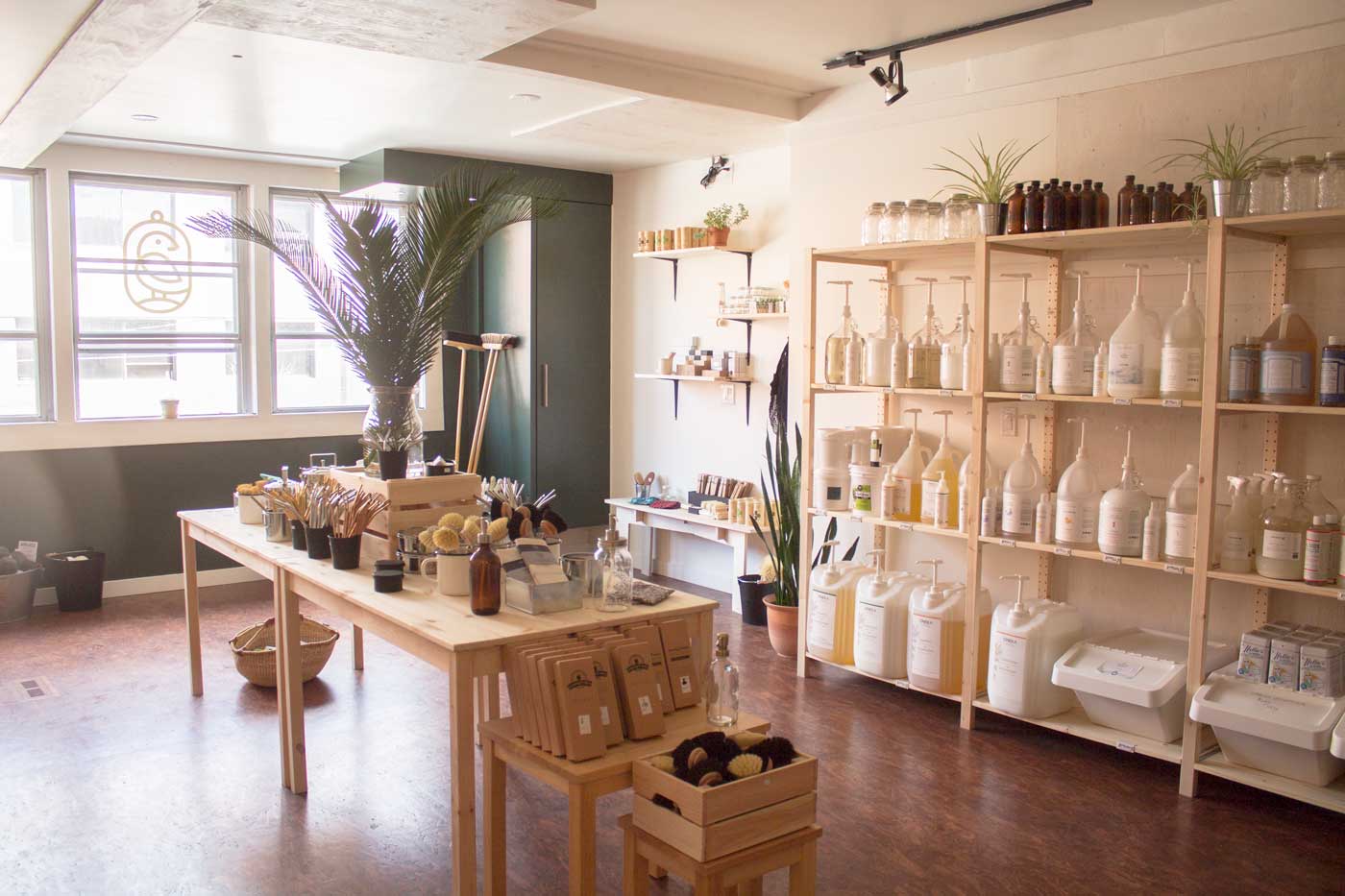
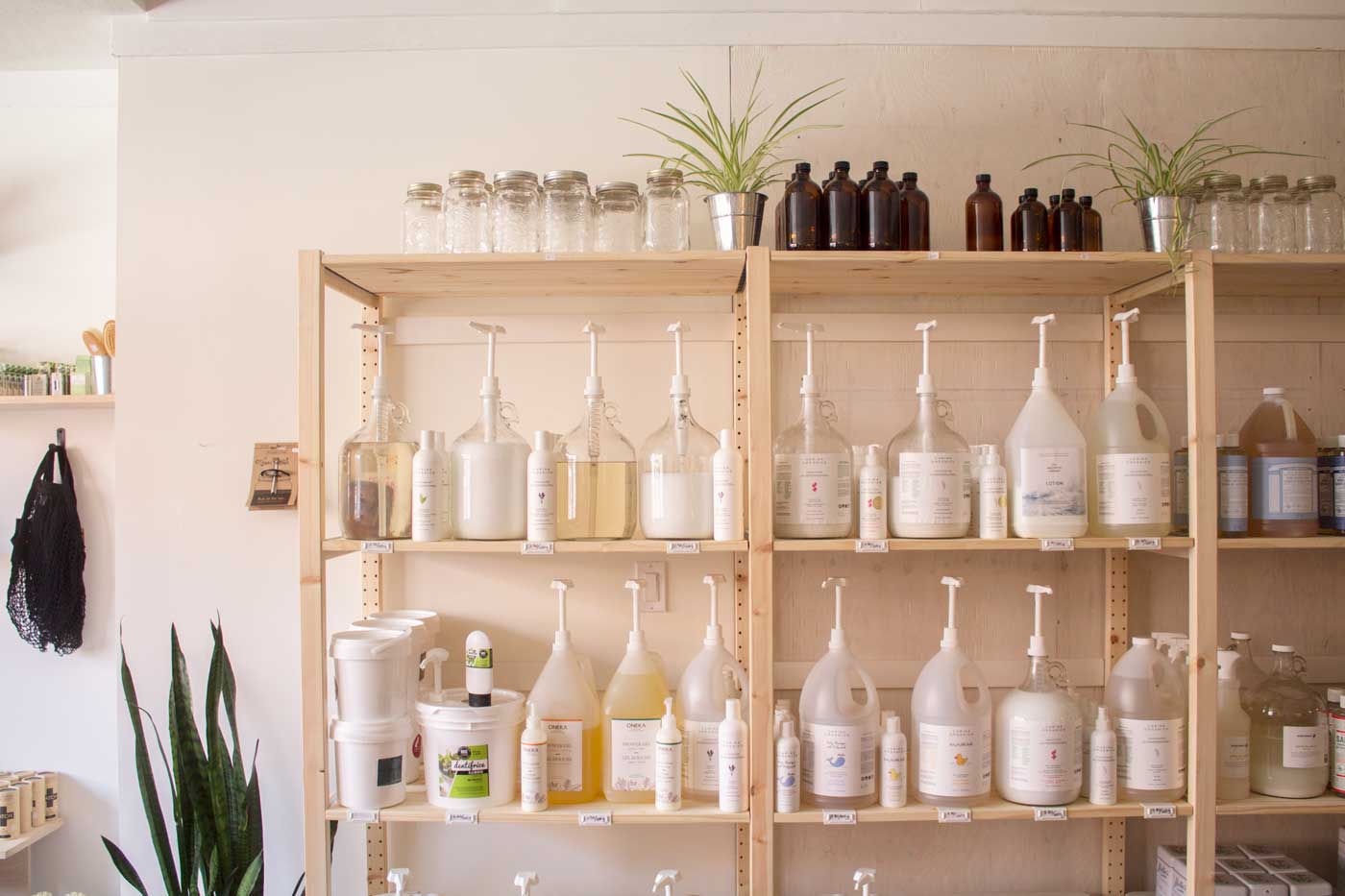 Canary carries a selection of refillable products, including cleaning vinegar, dish soap, lotion and all-purpose cleaner from The Unscented Company, shampoo, conditioner, body wash, bubble bath and hairspray from Carina Organics, mint toothpaste from Rose Citron, Routine deodorant and more. Shoppers can bring in a container to fill, grab a free used container from Canary (such as an old shampoo bottle) or buy a Boston round or mason jar to fill. All the refillable products are priced by weight.
Canary carries a selection of refillable products, including cleaning vinegar, dish soap, lotion and all-purpose cleaner from The Unscented Company, shampoo, conditioner, body wash, bubble bath and hairspray from Carina Organics, mint toothpaste from Rose Citron, Routine deodorant and more. Shoppers can bring in a container to fill, grab a free used container from Canary (such as an old shampoo bottle) or buy a Boston round or mason jar to fill. All the refillable products are priced by weight.
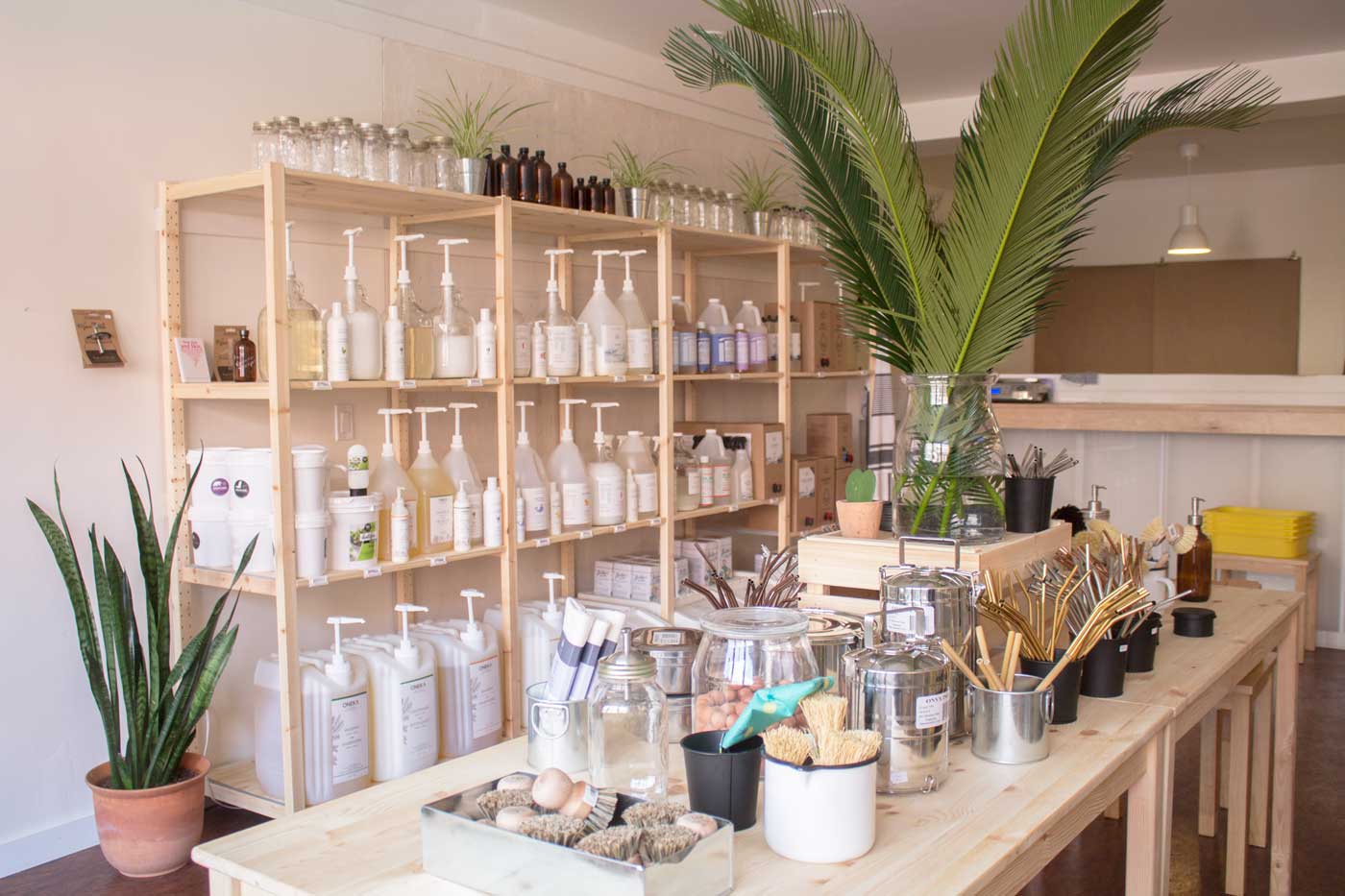
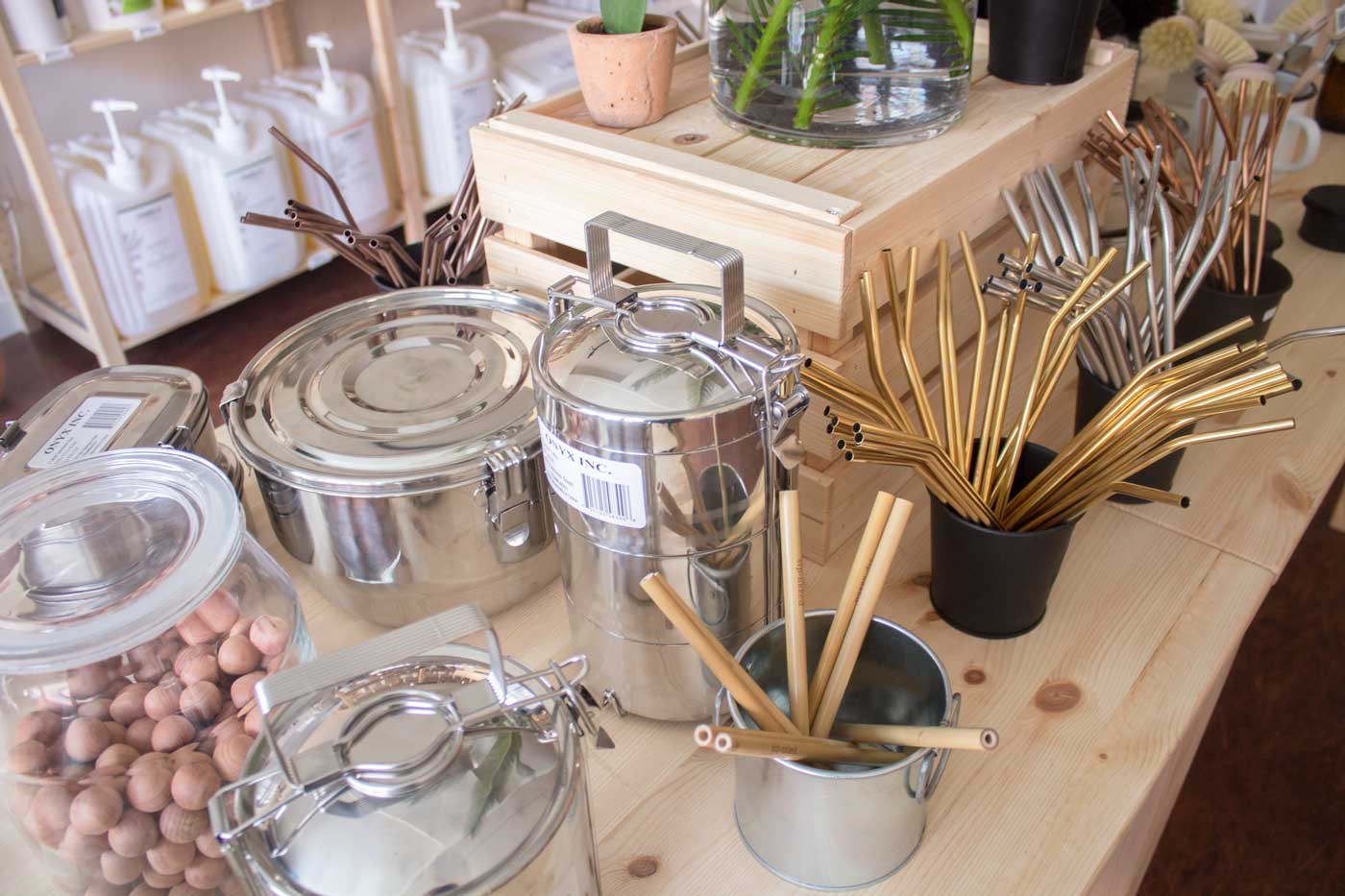 German company Burstenhaus Redecker makes these compostable feather dusters, brooms, toilet brushes and dish brushes with natural bristles.
German company Burstenhaus Redecker makes these compostable feather dusters, brooms, toilet brushes and dish brushes with natural bristles.
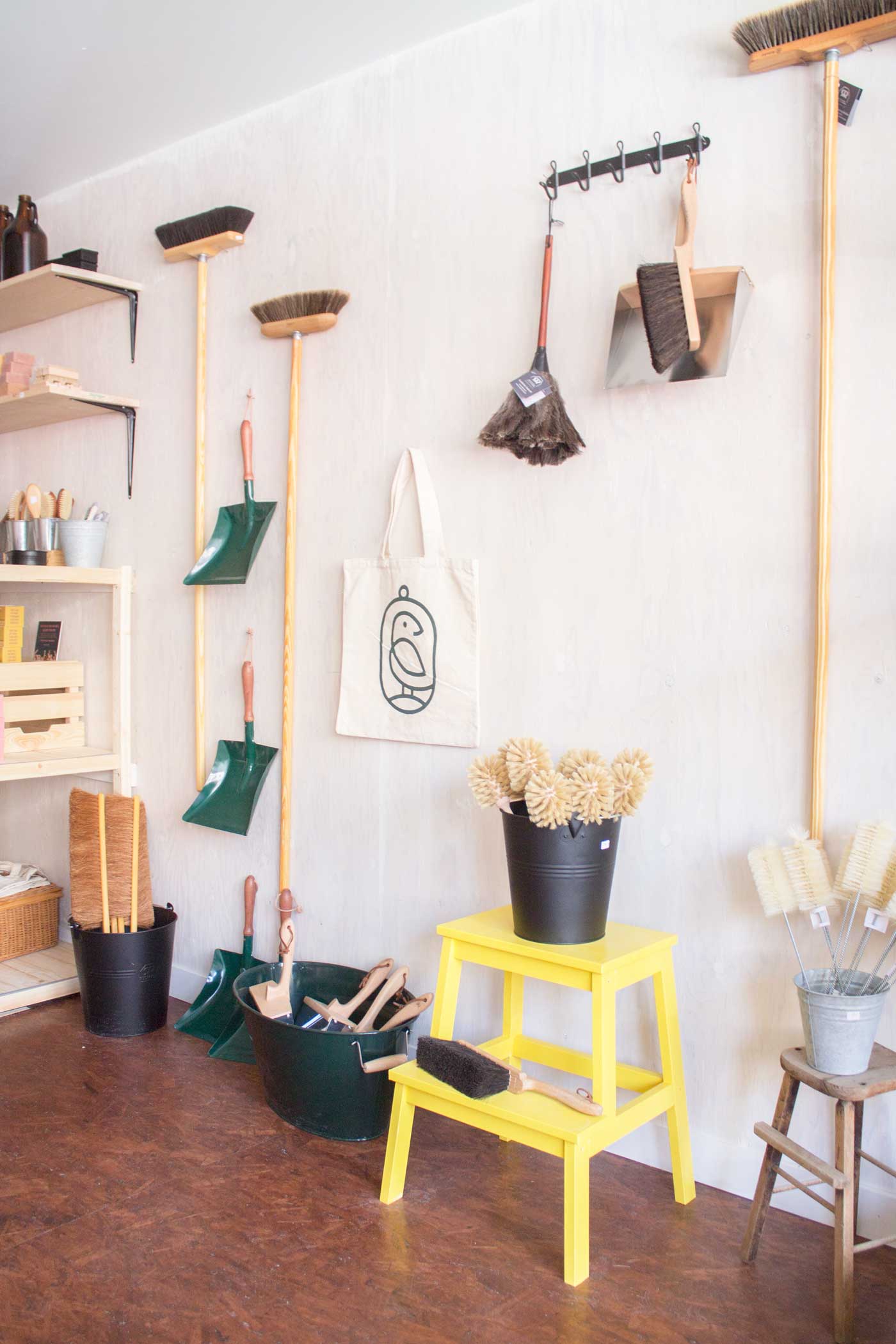 Looking for an alternative to plastic wrap? Try this beeswax food wrap from Abeego, which Meyer says have “the perfect amount of stick, but [aren’t] too sticky.”
Looking for an alternative to plastic wrap? Try this beeswax food wrap from Abeego, which Meyer says have “the perfect amount of stick, but [aren’t] too sticky.”
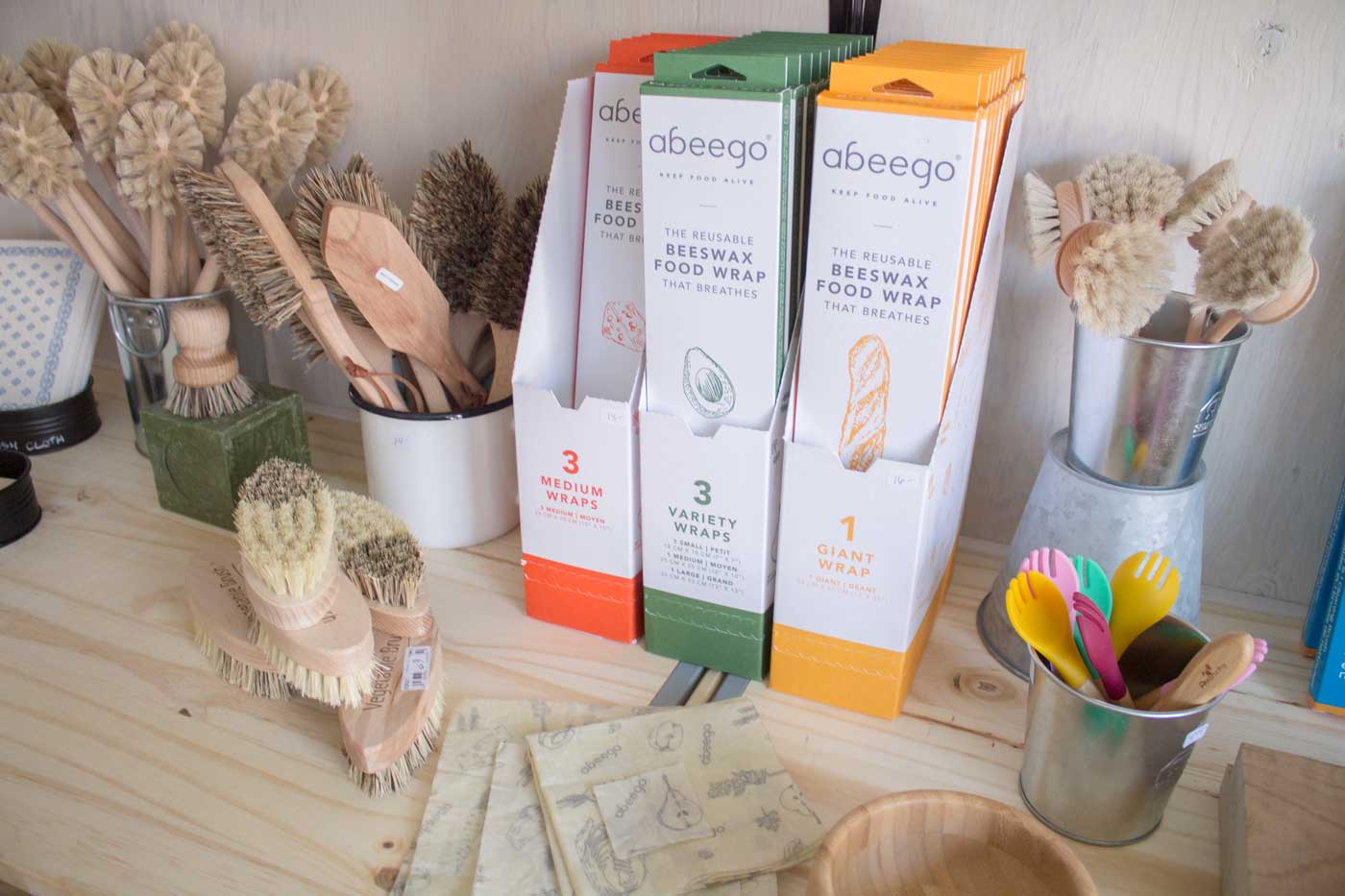 This natural toothpaste from American company Davids comes in a metal tube that can be recycled when it’s empty. Canary also has Brushed Naked bamboo toothbrushes that can ultimately be recycled and composted. If you’re looking to transition from plastic toothbrushes to more sustainable ones, Canary has a TerraCycle recycling box in-store where customers can dispose of their old ones.
This natural toothpaste from American company Davids comes in a metal tube that can be recycled when it’s empty. Canary also has Brushed Naked bamboo toothbrushes that can ultimately be recycled and composted. If you’re looking to transition from plastic toothbrushes to more sustainable ones, Canary has a TerraCycle recycling box in-store where customers can dispose of their old ones.
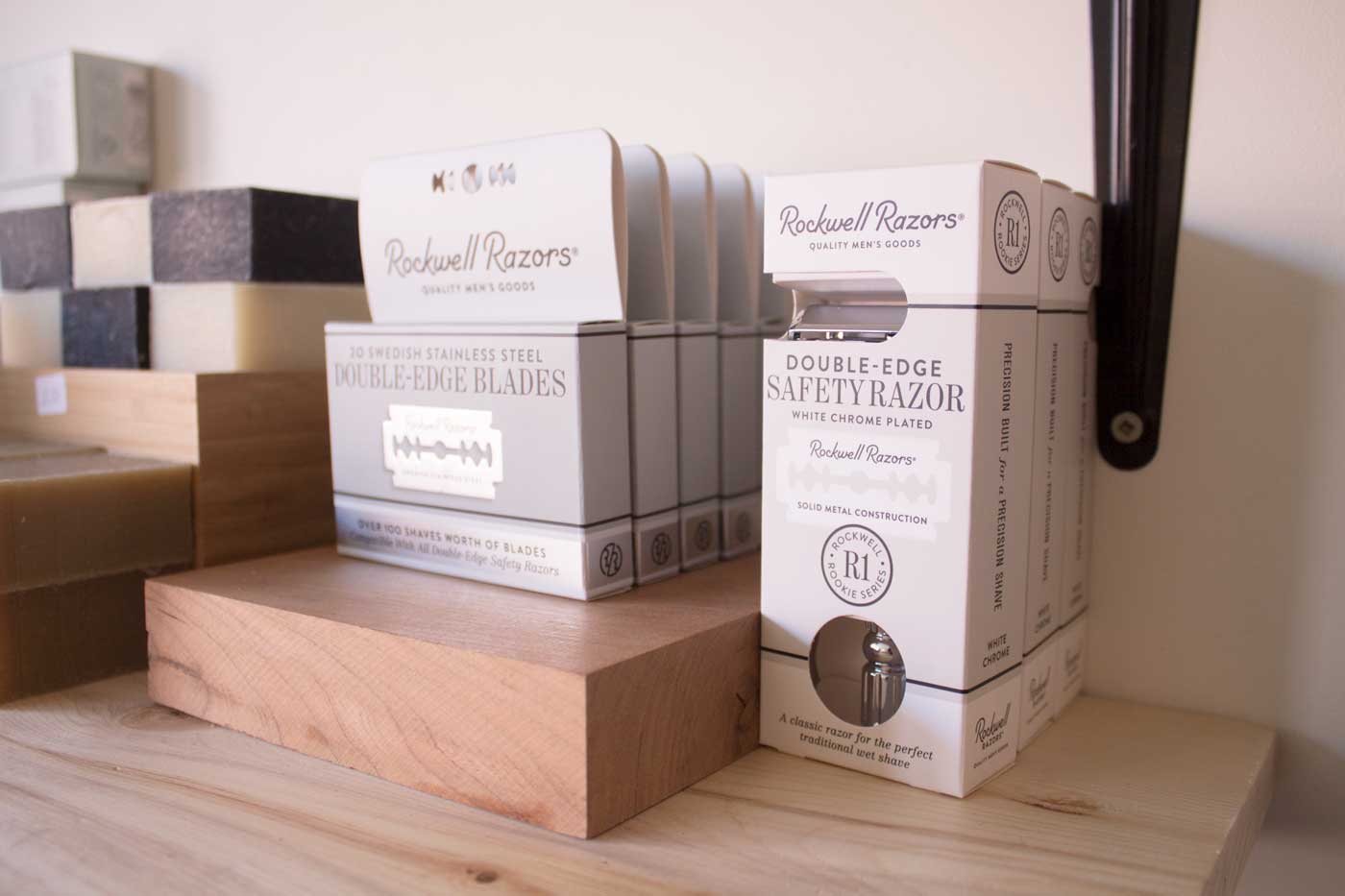 Canary carries safety razors with replaceable stainless steel blades. When customers are done with the used blades, they can bring them back to Canary to be recycled with a local metal recycler.
Canary carries safety razors with replaceable stainless steel blades. When customers are done with the used blades, they can bring them back to Canary to be recycled with a local metal recycler.
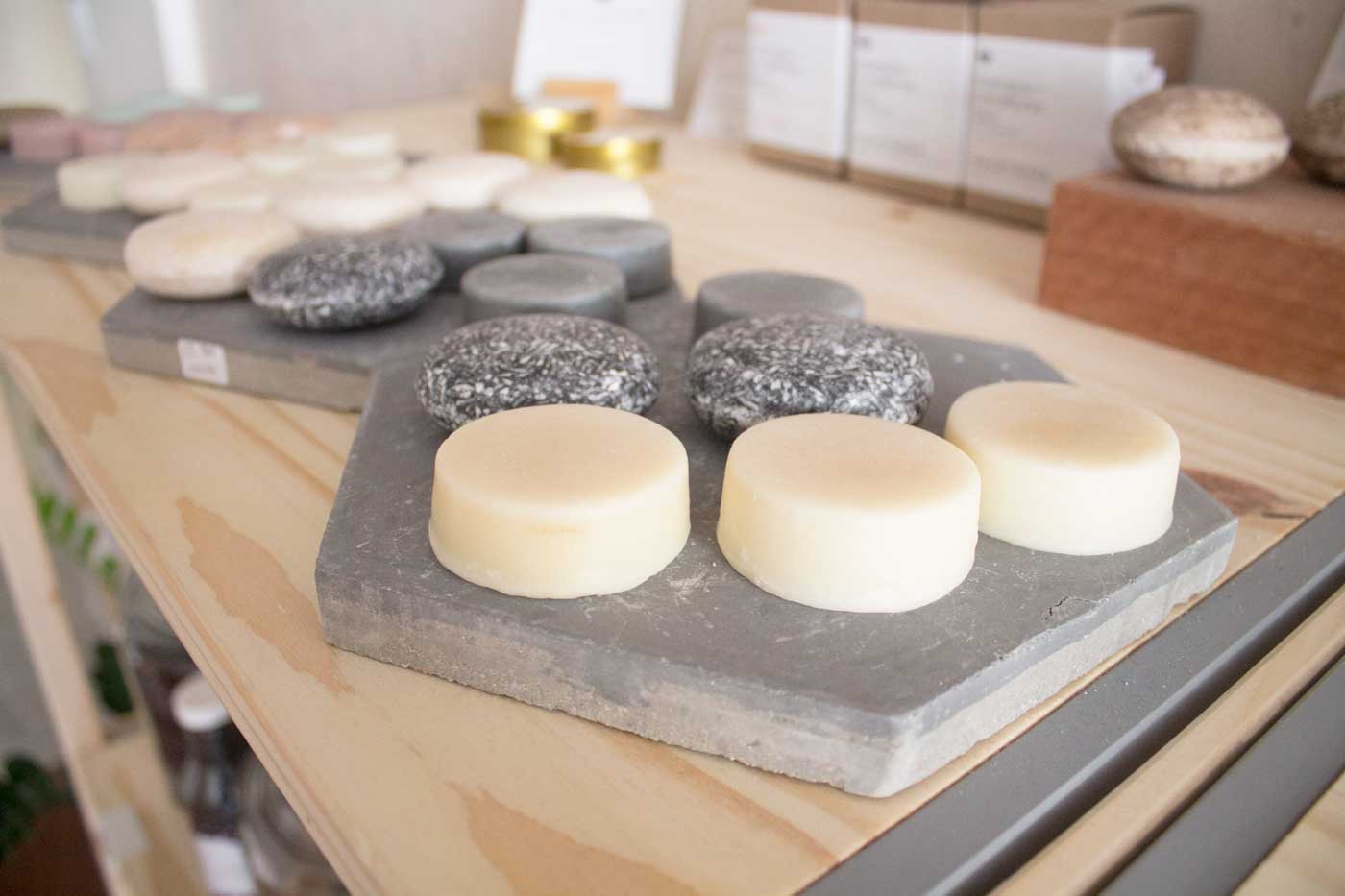
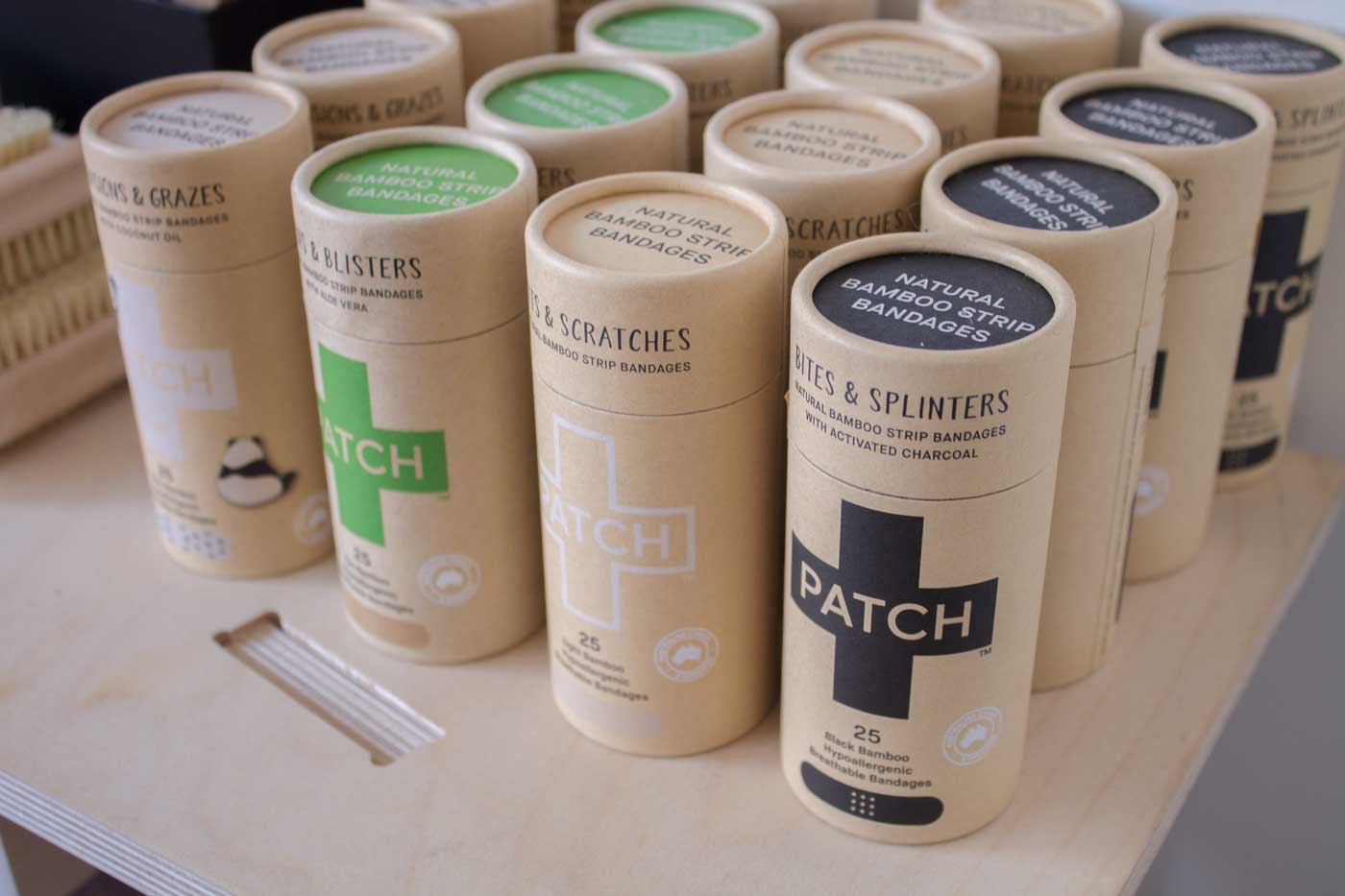 There’s even a sustainable option for bandages — Australian company Patch makes plastic-free (and beautifully designed) bamboo bandages that can be composted.
If you don’t want to to go with liquid shampoo and conditioner, Canary has zero waste shampoo and conditioner bars from Calgary company Unwrapped Life
There’s even a sustainable option for bandages — Australian company Patch makes plastic-free (and beautifully designed) bamboo bandages that can be composted.
If you don’t want to to go with liquid shampoo and conditioner, Canary has zero waste shampoo and conditioner bars from Calgary company Unwrapped Life



